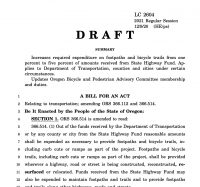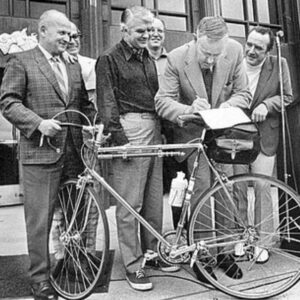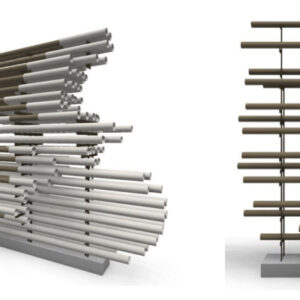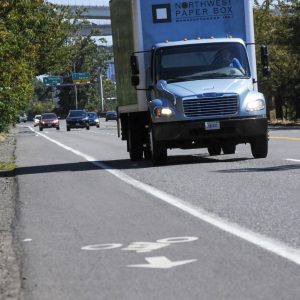
(Photo: Jonathan Maus/BikePortland)
When Oregon’s legislative session begins on January 19th, the Portland-based nonprofit Street Trust will embark on an effort to make the first major update the Bike Bill since it became law in 1971.

The draft bill will go even further than we reported on Tuesday in boosting the amount of money the state, cities and counties would be required to spend on bikeways and walkways. The Bike Bill’s most powerful language is the minimum expenditure clause, which states that all major road projects paid for by the state highway fund must allocate a minimum of 1% to “footpaths and bicycle trails.”
According to a copy of the draft bill (LC 2604, for “Legislative Council” a nonpartisan office in Salem that provides legal and publication services for legislators), the Street Trust will push to expand the 1% to 5%. They initially had the number at 3%, but Street Trust Co-director Greg Sutliff said yesterday they decided to make a “last-minute” change.
Advertisement
That change was recommended by former Street Trust board member and current Portland State University graduate student Hau Hagedorn. Hagedorn’s Bike Bill research (as part of her Masters of Public Administration capstone) was used as the basis of these reforms. According to her data, 1% of the state highway fund averaged about $7 million per year between 2014 and 2016 and ODOT spent about $7.7 million (slightly over the 1% minimum). A jump to 5% would boost that annual amount to $35 million.
“We got to the end of session and we needed a number, so someone just threw a number out. It was almost kind of random in a way.”
— Michael Ronkin, former ODOT manager recalling a story from Bike Bill creator Don Stathos
Over the past 30 years, Hagedorn used ODOT’s own internal analysis to determine the agency spent an average of about 1.1% of state highway fund dollars on bicycling and walking. She initially recommended 3% which would match how much ODOT spends on biking and walking from federal sources (which make up about 23% of ODOT’s total budget).
Here are the other changes to ORS 366.514 proposed in the draft bill:
– Would add “resurfaced” to the list of construction types that trigger the law. The law currently says the bike bill only comes into play when a highway, road, or street is “constructed, reconstructed, or relocated.” Paving projects often raise debates as to whether or not they rise to the level of “reconstructed”. Adding “resurfaced” is an attempt to expand and clarify the law.
– There are several exemptions in the law. One of them is that bikeways and walkways do not have to be funded if they, “would be excessively disproportionate to the need or probable use.” The Street Trust’s proposal would clarify that definition to, “would exceed twenty percent of the cost of the project.”
Advertisement
– In the section of the law that allows ODOT, cities and counties to choose what types of users are allowed on “footpaths and bicycle trails,” the draft bill would expand the list of allowed uses from “pedestrians” “nonmotorized vehicles” and “motorized wheelchairs” to include “electric assisted bicycles and motor assisted scooters”.
– In a bid for more oversight and transparency of how the law is implemented, the draft bill adds a new section that calls on ODOT to submit an annual report to the Governor that includes any requested exemptions to the law, the total expenditures made, and any “Information necessary to determine if the department is in compliance with the requirements of this section.”
– The bill would amend the definition of “bicycle trail” in the bill by adding, “‘Bicycle trail'” does not include the highway shoulder, as defined in ORS 801.480.” This is in response to Portland State University graduate student Hau Hagedorn’s research that found ODOT has used highway shoulder bikeways to fulfill bike bill requirements.
– The bill update would also expand the power of the Oregon Bicycle & Pedestrian Advisory Committee, a body created by the legislature in 1973. The Street Trust wants to expand the committee from eight to 11. The current law also limits the committee’s oversight role to, “advise the department [ODOT] regarding the regulation of bicycle traffic and the establishment of bicycle lanes and paths.” The new language would add more advisory responsibilities including: “… improving the processes and procedures used in implementing ORS 366.514 [Bike Bill],” “improvements to the department’s bicycle infrastructure design guidance,” “improvements to the department’s pedestrian infrastructure design guidance,” and “provide recommendations to the Oregon Transportation Commission on bicycle and pedestrian transportation projects, as provided by ORS 367.093 [an ODOT grant program that funds biking and walking projects].”
With the session about a month away, the Street Trust will have their work cut out for them to make such a substantive revision to this important law. While the session will move fast and present many challenges, in some ways The Street Trust has time on their side: 50 years is plenty of time to wait for an update.
And no lawmakers can argue that the 1% meant much to begin with — financially or technically-speaking. Michael Ronkin, a 22-year ODOT employee and former Bicycle and Pedestrian Program Manger, shared with me in an interview this week that the figure was nothing more than a whim. He relayed a conversation with Don Stathos, the late father of the Bike Bill, who once told him, “We got to the end of session and we needed a number, so someone just threw a number out. It was almost kind of random in a way.”
— Jonathan Maus: (503) 706-8804, @jonathan_maus on Twitter and jonathan@bikeportland.org
— Get our headlines delivered to your inbox.
— Support this independent community media outlet with a one-time contribution or monthly subscription.






Thanks for reading.
BikePortland has served this community with independent community journalism since 2005. We rely on subscriptions from readers like you to survive. Your financial support is vital in keeping this valuable resource alive and well.
Please subscribe today to strengthen and expand our work.
“The bill would amend the definition of “bicycle trail” in the bill by adding, “‘Bicycle trail’” does not include the highway shoulder, as defined in ORS 801.480.” This is in response to Portland State University graduate student Hau Hagedorn’s research that found ODOT has used highway shoulder bikeways to fulfill bike bill requirements.”
Thank you so much Hau and Street trust! We appreciate your work. Please amend to “bike infrastructure must include physical barrier, or grade separation.” Otherwise ODOT will be producing unridable, narrow, paint-only designs as we see on 30B. Time to donate folks.
If ODOT wants the highway shoulder to be considered the required bicycle facility, then it would have to be continuous, maintained, and posted with signs visible to conflicting traffic, wouldn’t it?
I’d ride to the coast on a road like that.
This bill strikes me a great way to provoke anticyclist sentiment and knee jerk opposition to anything regarding bikes. It outright makes no sense except in certain situations. Not allowing the highway shoulder to count is ridiculous, and if these paths are actually built, expect hopeless maintenance and practically no use.
One of my former bicycle commutes involved riding between Monmouth and Salem for 5 years. Just so happens, there’s a separated path from Monmouth to Rickreal, and there’s another from 51 and 22 into Salem.
I tried the paths a couple times, but they were such garbage — super bumpy from root incursions, blackberries all over, and junkies as you got closer to Salem that I never took them and rode 99 and 22 (or 51 and 22 depending on my mood). The path along 99 got really light usage among recreational people in perfect weather, but was basically unused. The path along 22 was desolate except for junkies. I would have much preferred a shoulder along 99 or 51 as neither had them in those sections and traffic was fast.
This bill will go down in flames and will only perpetuate the view that cycling support is the domain of a tiny number of Portlanders who have no connection with reality.
Figuring out where infrastructure would be helpful and how to pay for it is worthwhile. How to throw tons of money at something that’s really mostly about optics is not.
Comment of the week!
It makes sense in some locations for independent paths, but in others, as explained by Kyle, a highway shoulder is the only reasonable solution. Insist on independent paths and the result will be NO accommodation for bicycles or pedestrians.
I’ve ridden in Europe, the Oregon Coast bike route, and across the country. I’ve seen good and bad facilities. There is not a one-size-fits-all solution.
Not sure if you two are reading this right. I think what they’re saying is that ODOT can’t do a big expensive highway project and point to the shoulders of the highway as a reasonable exemption from setting aside funds for bikeways and walkways (something they’ve done in the past). The amendment wants them to still set aside the money even if the highway project has rideable shoulders. The bill is saying shoulders are not sufficient enough for cycling to quality as “bike bill” expenditures. The new bill language is NOT calling for any mandates to build paths of any kind.
Does that mean 5% of the funds for highway projects in sparsely populated areas of the state go to cycling?
If so, it’s a massive subsidy that benefits urban dwellers who already have it great compared to most. Better than needlessly condemning and paving property in the middle of nowhere, but I still can’t see getting much buy in for an idea like that.
Can be spent on bikeways OR walkways. In fact, legend has it that Stathos only added the “footpaths” clause to get rural legislators on board.
Doesn’t sound like he talked to them to see what might work. Not sure how that would be appealing. The dollar figures are huge and I’d never even heard of walking being an issue before moving to PDX. I suppose tourist trails that bring in people who patronize businesses could be seen as a plus, but it’s not like there aren’t plenty and they still need to offer something cool enough that people are willing to drive for hours to walk on them.
If the legislators in favor offer something sufficiently huge (that may have no relation), it could get support.
But I’m skeptical. The destruction from the wildfires was profound and fallout from COVID was devastating to many communities — approaching some of these representatives with the idea this is deserving of attention, let alone appealing, strikes me as tone deaf.
If there needs to be more money for infrastructure, the funding needs to come from the areas that will benefit. In Portland where space is at a premium and vehicle infrastructure is strained, one can make arguments as to how boosting cycling/walking/transit helps everyone. It’s much harder where there is nothing but space and the very few walkers and cyclists do just fine.
I think footpath included snow mobile and motorbike trails which are more popular in rural areas (just look for scuffmarks on the asphalt.)
These are genuinely popular. It’s one of the reasons I like steep rocky terrain. No ground-based machine can deal with that — it’s the only way to escape the internal combustion engine racket.
Jonathan, I think you are incorrect. It does mandate footpaths and bicycle trails even for a wide variety of projects, including resurfacing.
The opening paragraph of Section 1 includes the following:
Footpaths and bicycle trails, including curb cuts or ramps as part of the project, shall be provided wherever a highway, road or street is being constructed, reconstructed, resurfaced or relocated. [resurfaced is the newly added qualifying event.]
10 (b) goes further by specifying that a shoulder does not qualify as a bicycle trail.
I think it’s pretty clear that LC2604 will require separate bicycle trails for a huge variety of projects. The exception of twenty percent as specified in 2(b) would allow the agency to avoid putting in the paths and trails.
The obvious outcome will be for the agency to design the separate trail; calculate the cost; show that the cost exceeds 20 percent of the project cost and implement nothing. Look at something like OR 22 going to the coast, next time it’s resurfaced would you like them to try to squeeze a couple feet of paved shoulder in or would you prefer that they design a separate path, calculate that the cost of widening would be in the millions and do nothing?
I think we’re getting bogged with down in semantics of “path” vs “bikeway/walkway”. Yes every project that triggers the bike bill must build a bikeway or walkway – unless a case for exemption can be made. Also keep in mind this isn’t about “me”. I’m just reporting what Street Trust is proposing. I don’t represent this idea or this bill. I’m just the messenger and I try to share what I know whenever possible.
The law is all about semantics. I’m glad you are reporting about it. I’ve spent lots of time in my career dealing with the law and its interpretation; I’m just trying to point out what I think are flaws in the proposal.
I appreciate your insights. And I’m grateful that you share them with us here.
So what you are saying, and correct me if I am wrong, is that the already-funded outer Powell project in Portland where the added sidewalks and cycletracks which account for more than 20% of the project cost, could then be legally cancelled by ODOT if this Street Trust sponsored legislation is passed, and the money could be diverted to the Rose Quarter project that has no bike or sidewalk facilities to speak of? Is that what you are saying? And JM supports this?
I think there’s enough confusion to think LC2604 could allow cancellation of Powell under the 20 percent exemption standard. JM indicates he’s a reporter rather than an advocate or sponsor of the bill.
I used the I-205 Abernethy Bridge to Stafford Road reconstruction project as a case study. ODOT cited all three exemptions – safety, excessive cost, and other other available ways – as justification for doing the bare minimum which includes widening the freeway shoulders to 12 feet to accommodate pedestrians. They actually looked at building a separate bike/ped bridge and a parallel path which would have been less than 20%. However, they felt the cost was excessively disproportionate. The 20% is a recommendation by the FHWA. The law is outdated and full of loopholes. The recommendations aren’t perfect but skim the report. The law is outdated. There are plenty of complete streets legislation across the country that are more current.
The definition used in the bill is: “As used in this section, “bicycle trail” means a publicly owned and maintained lane or way designated and signed for use as a bicycle route.”
The Bill doesn’t call for just building multiuse paths. A shoulder is reasonable, but is it on the Interstate system like I-205? If ODOT puts up a sign that says it’s a bikeway as the law is currently written, they are compliant with the law and they don’t have to do anything else to accommodate bicyclists and pedestrians.
This is an excellent example of the vehicular cycling ideology of the last 50 years that plagues Portland and has stagnated our modal share for a decade. 1) The belief that physically separated infrastructure is a radical idea 2) Belief that physical separation is unnecessary for safety (we just need to get over it) 3) Belief that bike paths must be smooth like highways 4) Belief that no one really uses them except during nice weather 5) Belief that funding separated infrastructure is just about optics
Your anecdote about the junky bike path is a great argument for increasing the state spending levels on bike infrastructure. Thanks!
Kyle, I want to say how much I appreciate your comments on this blog. Always sensible, measured, and evidence-based.
maybe the solution is to allow the funds to be used for maintenance as well as construction so that those problems could be resolved
Kyle . The sidepath on 99W – between Rickreall and Monmouth may have been in poor condition back in the day, but it was resurfaced with ARRA money in the last 10 years and is just the kind of facility that less than avid cyclists are attracted to and well served by. FYI, it now gets lots of use by folks who are just starting to stretch their cycling wings to take in longer rides. If it were just a “shoulder bikeway” they wouldn’t be there. (Even us avid cyclists can appreciate separation from traffic and a safe, side-by-side conversation as we ride.) It ain’t all one or the other, but the separated paths do have their place.
I would have ridden it if it were any good when I had my commute as that section is only rideable for people with high comfort levels with fast moving traffic passing close. I didn’t particularly care for that section (or 22), though that short section of Rickreal highway is fairly nice.
Having said that, there are a bunch of low traffic agricultural roads in that area that are a million times more interesting/enjoyable that lead to much more interesting places and provide a gentle introduction to traffic where you can safely ride side by side. And that’s where I took people who were getting started out.
I don’t have a general objection to separated paths — in some places, they make sense, and I am on board with the general logic that people need places to build confidence/skills/comfort. But getting more people out ultimately depends on enough of them getting beyond the idea that they only can ride in very specific places and conditions.
I am glad to hear the path getting some use. Once the weather turned, I could go months without seeing a single cyclist and I was out there every day. You’d think runners may have liked it since the blackberries and bumps wouldn’t be such a big deal, but I think they also chose quieter routes nearby.
This is such a breath of fresh air. An actual, substantive change to a major law. I’m so grateful for Hau’s work and for Street Trust going for this.
One quick thought: If we’re opening up the Bike Bill, it’d be a good time to change that outdated “bicycle trail and footpath” language to “bikeways and walkways”. And to give credit where it’s due, ODOT themselves says they’re outdated and recommends this change https://www.oregon.gov/ODOT/Programs/TDD%20Documents/Interpretation-of-ORS-366.514.pdf
I wonder if the Board of Directors of the Street Trust is getting an overhaul? A lot of those people have been on the board for a long time. We need some new energy engaged to pass this through the long session. Are the Board Members pulling up others around them and handing over the batons? I hope so. We need real leaders to show up and testify IN PERSON. The legislature needs to see new faces, stories and real passion to get this passed. Not the status quo. Everybody needs to testify for the next 6 months not just once multiple times.
I completely disagree, there are no longtime board members of the street trust and that is part of the problem. There is not even one board member who has been there for 10 years. A lack of institutional knowledge is one of the things that has hamstrung the street trust in recent years.
The conditions along that path is DEPLORABLE. There’s often shattered glass on the path and right now, they have a shoebox sized spent junkie syringe disposal bins.
Looks like PSU Transport department is finally flexing their policy chops in Oregon!!! Bulk up and get the bike lanes built!! Great job everybody! The only think to add is a new sub-committee on AI in transport. We need to start exploring ways to use technology to slow down vehicles in urban areas. And or take that up as a policy research topic area, codified in code to make sure there is some space somewhere for these discussions to occur transparently. ODOTs ATM team should be avoided for this. This could free up police resources and improve equity outcomes.